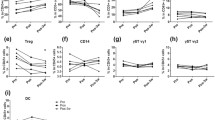Abstract.
Whole body hyperthermia (WBH) has been used as an adjunct to radio-/chemotherapy in patients with various malignant diseases. Although clear evidence is still missing, it has been hypothesized that an activation of the immune system might contribute to the therapeutic effect of WBH. To examine whether a treatment with 60-minute 41.8°C WBH as an adjunct to chemotherapy (WBH-CT) induces an activation of T cells, blood samples were collected at numerous time points before and up to 48 h post-treatment. The aim of this study was to examine the effect of WBH-CT on the expression of a broad range of activation markers on peripheral blood lymphocytes (PBL), on serum cytokines and intracellular cytokine levels in T cells, and the capacity of these cells to proliferate. Immediately after 41.8 °C WBH-CT treatment, a drastic increase in peripheral natural killer (NK) cells (P<0.05) and CD56+ cytotoxic T lymphocytes (CTL; P<0.01) in the patients' peripheral blood was observed. At 5 h post-treatment, the percentages of both effector cell types had returned to baseline levels. This transient phenomenon was accompanied by a short period of reduced T cell activity, indicated by diminished serum levels of soluble interleukin-2 receptors (sIL-2R) at 3 h post-WBH-CT (P<0.05) and decreased lymphocytic proliferation at the same point in time. This first phase was followed by a marked but short-lived increase in the patients' serum levels of interleukin-6 (IL-6; P<0.01) during the first 5 h following treatment, with a subsequent decrease to baseline levels at 24 h and significantly increased serum levels of tumor necrosis factor-α (TNF-α) at 0 h (P<0.01), 3 h (P<0.05), 5 h (P<0.05) and 24 h (P<0.01) post-WBH-CT. The third phase of the immunological consequences of WBH-CT consisted of an increase in the percentage of peripheral cytotoxic T lymphocytes (CTL) expressing CD56, reaching a maximum at 48 h post-WBH (P<0.01). Furthermore, the percentage of CD4+ T cells expressing the T cell activation marker CD69 increased nearly two-fold over time, reaching its maximum at 48 h (P<0.05). As an additional marker for T cell activation, serum levels of sIL-2R increased markedly (P<0.01), reaching maximum levels at the same point in time. Elevated intracellular concentrations of interferon-gamma (IFN-γ) and/or TNF-α in CD8+ T cells were found in 4 out of 5 patients at 24 h post-WBH-CT. Since similar changes were not observed in patients receiving chemotherapy alone, this is the first study to provide evidence for prolonged WBH-CT-induced activation of human T cells.
Similar content being viewed by others
Author information
Authors and Affiliations
Additional information
Electronic Publication
Rights and permissions
About this article
Cite this article
Atanackovic, D., Nierhaus, A., Neumeier, M. et al. 41.8°C whole body hyperthermia as an adjunct to chemotherapy induces prolonged T cell activation in patients with various malignant diseases. Cancer Immunol Immunother 51, 603–613 (2002). https://doi.org/10.1007/s00262-002-0327-x
Received:
Accepted:
Issue Date:
DOI: https://doi.org/10.1007/s00262-002-0327-x




